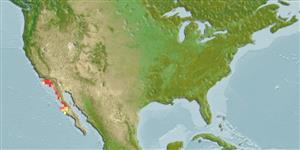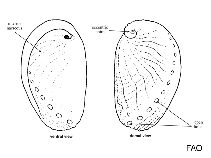Haliotis sorenseni Bartsch, 1940
White abalone| Native range | All suitable habitat | Point map | Year 2050 |

|
| This map was computer-generated and has not yet been reviewed. |
| Haliotis sorenseni AquaMaps Data sources: GBIF OBIS |
Upload your photos
Google image | No image available for this species;
drawing shows typical species in Haliotidae.
Google image | No image available for this species;
drawing shows typical species in Haliotidae.
Classification / Names Common names | Synonyms | CoL | ITIS | WoRMS
Gastropoda | Lepetellida | Haliotidae
Environment: milieu / climate zone / depth range / distribution range Ecology
Benthic; depth range 20 - 66 m (Ref. 101453), usually 43 - 60 m (Ref. 101453). Subtropical; 34°N - 26°N, 121°W - 112°W
Distribution Countries | FAO areas | Ecosystems | Occurrences | Introductions
Eastern Pacific: USA to Mexico. From Point Conception, California to Punta Abreojos in Baja California.
Length at first maturity / Size / Weight / Age
Maturity: Lm ?, range 9 - 13.4 cm Max length : 25.0 cm TL male/unsexed; (Ref. 865); max. reported age: 40 years (Ref. 105226)
Historically, found at depths between 25 and 30 m and reported to be formerly common in depths of 10 to 20 m (Ref. 101453). Minimum depth from Ref. 106850. Sedentary (Ref. 106850). Found in open low relief rock or boulder habitat surrounded by sand, often at the sand-rock interface (Ref. 101461). Also occurs in open, exposed deep-water reefs with kelp understory (Ref. 106850). Feeds on drift macroalgae and attached red algae (Ref. 101622).
Life cycle and mating behavior Maturity | Reproduction | Spawning | Eggs | Fecundity | Larvae
Broadcast spawners. Life cycle: Embryos develop into planktonic trocophore larvae and later into juvenile veligers before becoming fully grown adults (Ref. 833). Also Refs. 105220, 105232.
Main reference
References | Coordinator | Collaborators
Bisby, F.A., M.A. Ruggiero, K.L. Wilson, M. Cachuela-Palacio, S.W. Kimani, Y.R. Roskov, A. Soulier-Perkins and J. van Hertum. 2005. (Ref. 19)
IUCN Red List Status (Ref. 130435)
Critically Endangered (CR) (A2acd+3cd+4acd); Date assessed: 11 November 2018
CITES status (Ref. 108899)
Not Evaluated
CMS (Ref. 116361)
Not Evaluated
Threat to humans
Human uses
Fisheries: commercial
| FishSource |
Tools
More information
Internet sources
BHL | BOLD Systems | CISTI | DiscoverLife | FAO(Publication : search) | Fishipedia | GenBank (genome, nucleotide) | GloBI | Gomexsi | Google Books | Google Scholar | Google | PubMed | Tree of Life | Wikipedia (Go, Search) | Zoological Record



